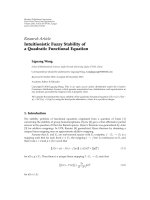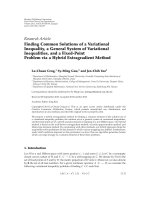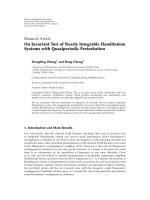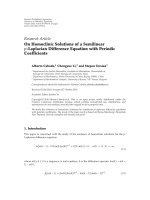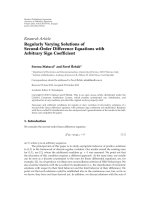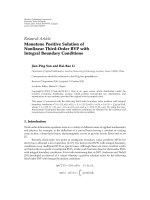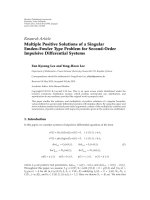Báo cáo hóa học: "Research Article The C1 Solutions of the Series-Like Iterative Equation with Variable Coefficients/; potx
Bạn đang xem bản rút gọn của tài liệu. Xem và tải ngay bản đầy đủ của tài liệu tại đây (469.58 KB, 7 trang )
Hindawi Publishing Corporation
Fixed Point Theory and Applications
Volume 2009, Article ID 173028, 7 pages
doi:10.1155/2009/173028
Research Article
The C
1
Solutions of the Series-Like Iterative
Equation with Variable Coefficients
Yuzhen Mi, Xiaopei Li, and Ling Ma
Mathematics and Computational School, Zhanjiang Normal University, Zhanjiang,
Guangdong 524048, China
Correspondence should be addressed to Xiaopei Li,
Received 23 March 2009; Revised 11 June 2009; Accepted 6 July 2009
Recommended by Tomas Dom
´
ınguez Benavides
By constructing a structure operator quite different from that ofZhang and Baker 2000 and using
the Schauder fixed point theory, the existence and uniqueness of the C
1
solutions of the series-like
iterative equations with variable coefficients are discussed.
Copyright q 2009 Yuzhen Mi et al. This is an open access article distributed under the Creative
Commons Attribution License, which permits unrestricted use, distribution, and reproduction in
any medium, provided the original work is properly cited.
1. Introduction
An important form of iterative equations is the polynomial-like iterative equation
λ
1
f
x
λ
2
f
2
x
··· λ
n
f
n
x
F
x
,x∈ I :
a, b
, 1.1
where F is a given function, f is an unknown function, λ
i
∈ R
1
i 1, 2, ,n, and f
k
k
1, 2, ,n is the kth iterate of f, that is, f
0
xx, f
k
xf ◦ f
k−1
x. The case of all
constant λ
i
s was considered in 1–10. In 2000, W. N. Zhang and J. A. Baker first discussed
the continuous solutions of such an iterative equation with variable coefficients λ
i
λ
i
x
which are all continuous in interval a, b. In 2001, J. G. Si and X. P. Wang furthermore gave
the continuously differentiable solution of such equation in the same conditions as in 11.In
this paper, we continue the works of 11, 12, and consider the series-like iterative equation
with variable coefficients
∞
i1
λ
i
x
f
i
x
F
x
,x∈ I :
a, b
, 1.2
2 Fixed Point Theory and Applications
where λ
i
x : I → 0, 1 are given continuous functions and
∞
i1
λ
i
x1,λ
1
x ≥ c>
0 ∀x ∈ I, max
x∈I
λ
i
xc
i
. We improve the methods given by the authors in 11, 12,and
the conditions of 11, 12 are weakened by constructing a new structure operator.
2. Preliminaries
Let C
0
I,R{f : I → R,fis continuous}, clearly C
0
I,R, ·
c
0
is a Banach space, where
f
c
0
max
x∈I
|fx|,forf in C
0
I,R.
Let C
1
I,R{f : I → R,f is continuous and continuously differentiable}, then
C
1
I,R is a Banach space with the norm ·
c
1
, wheref
c
1
f
c
0
f
c
0
,forf in C
1
I,R.
Being a closed subset, C
1
I,I defined by
C
1
I,I
f ∈ C
1
I,R
,f
I
⊆ I, ∀x ∈ I
2.1
is a complete space.
The following lemmas are useful, and the methods of proof are similar to those of
paper 4, but the conditions are weaker than those of 4.
Lemma 2.1. Suppose that ϕ ∈ C
1
I,I and
ϕ
x
≤ M, ∀x ∈ I, 2.2
ϕ
x
1
− ϕ
x
2
≤ M
|
x
1
− x
2
|
, ∀x
1
,x
2
∈ I, 2.3
where M and M
are positive constants.Then
ϕ
n
x
1
−
ϕ
n
x
2
≤ M
2n−2
in−1
M
i
|
x
1
− x
2
|
, 2.4
for any x
1
,x
2
in I,whereϕ
n
denotes dϕ
n
/dx.
Lemma 2.2. Suppose that ϕ
1
,ϕ
2
∈ C
1
I,I satisfy 2.2.Then
ϕ
n
1
− ϕ
n
2
c
0
≤
n
i1
M
i−1
ϕ
1
− ϕ
2
c
0
. 2.5
Lemma 2.3. Suppose that ϕ
1
,ϕ
2
∈ C
1
I,I satisfy 2.2 and 2.3.Then
ϕ
k1
1
−
ϕ
k1
2
c
0
≤
k 1
M
k
ϕ
1
− ϕ
2
c
0
Q
k 1
M
k
i1
k − i 1
M
ki−1
ϕ
1
− ϕ
2
c
0
,
2.6
for k 0, 1, 2, ,where Qs0 as s 1 and Qs1 as s 2, 3,
Fixed Point Theory and Applications 3
3. Main Results
For given constants M
1
> 0andM
2
> 0, let
A
M
1
,M
2
ϕ ∈ C
1
I,I
:
ϕ
x
≤ M
1
, ∀x ∈ I,
ϕ
x
1
− ϕ
x
2
≤ M
2
|
x
1
− x
2
|
, ∀x
1
,x
2
∈ I
.
3.1
Theorem 3.1 existence. Given positive constants M
1
,M
2
and F ∈AM
1
,M
2
, if there exists
constants N
1
≥ 1 and N
2
> 0, such that
P
1
c −
∞
i2
c
i
N
i−1
1
≥ M
1
/N
1
,
P
2
c −
∞
i2
c
i
2i−2
ji−1
N
j
1
≥ M
2
/N
2
,
then 1.2 has a solution f in AN
1
,N
2
.
Proof. For convenience, let d max{|a|, |b|}.
Define K : AN
1
,N
2
→ C
1
I,I such that K : f → K
f
, where
K
f
t
∞
i1
λ
i
x
f
i
t
, ∀x, t ∈ I. 3.2
Since f ∈AN
1
,N
2
, it is easy to see that |f
i
t|≤d for all t ∈ I,and|λ
i
xf
i
t|≤d|λ
i
x| for
all x,t ∈ I. It follows from
∞
i1
λ
i
x1that
∞
i1
λ
i
xf
i
t is uniformly convergent. Then
K
f
t is continuous for t ∈ I. Also we have
a
∞
i1
λ
i
x
a ≤
∞
i1
λ
i
x
f
i
t
≤
∞
i1
λ
i
x
b b, 3.3
thus K
f
∈ C
0
I,I.
For any f ∈AN
1
,N
2
, we have
d
dt
λ
i
x
f
i
t
λ
i
x
f
f
i−1
t
f
i−1
t
≤ c
i
N
i
1
. 3.4
By condition P
1
,weseethat
∞
i1
c
i
N
i
1
is convergent, therefore
∞
i1
c
i
f
i
t
is uniformly
convergent for t ∈ I,thisimpliesthatK
f
t is continuously differentiable for t ∈ I. Moreover
d
dt
K
f
t
≤
∞
i1
λ
i
x
f
i
t
≤
∞
i1
c
i
N
i
1
: μ
1
. 3.5
4 Fixed Point Theory and Applications
By Lemma 2.1,
d
dt
K
f
t
1
−
d
dt
K
f
t
2
≤
∞
i1
λ
i
x
f
i
t
1
−
f
i
t
2
≤
∞
i1
c
i
⎛
⎝
N
2
2i−2
ji−1
N
j
1
⎞
⎠
|
t
1
− t
2
|
: μ
2
|
t
1
− t
2
|
.
3.6
Thus K
f
∈Aμ
1
,μ
2
.
Define T : AN
1
,N
2
→ C
1
I,I as follows:
Tf
t
1
λ
1
x
F
t
−
1
λ
1
x
K
f
t
f
t
, ∀t, x ∈ I, 3.7
where f ∈AN
1
,N
2
. Because K
f
, F, and f are continuously differentiable for all t ∈ I, Tf
is continuously differentiable for all t ∈ I. By conditions P
1
and P
2
, for any t
1
,t
2
in I, we
have
d
dt
Tf
t
≤
1
λ
1
x
F
t
1
λ
1
x
∞
i2
λ
i
x
f
i
t
≤
1
c
M
1
1
c
∞
i2
c
i
N
i
1
≤
1
c
M
1
1
c
cN
1
− M
1
N
1
.
3.8
We furthermore have
d
dt
Tf
t
1
−
d
dt
Tf
t
2
≤
1
λ
1
x
F
t
1
− F
t
2
1
λ
1
x
∞
i2
c
i
f
i
t
1
−
f
i
t
2
≤
1
c
M
2
|
t
1
− t
2
|
1
c
∞
i2
c
i
N
2
⎛
⎝
2i−2
ji−1
N
j
1
⎞
⎠
|
t
1
− t
2
|
≤ N
2
|
x
1
− x
2
|
.
3.9
Thus T : AN
1
,N
2
→AN
1
,N
2
is a self-diffeomorphism.
Now we prove the continuity of T under the norm ·
c
1
. For arbitrary f
1
,f
2
∈
AN
1
,N
2
,
Fixed Point Theory and Applications 5
Tf
1
− Tf
2
c
0
max
t∈I
−
1
λ
1
x
K
f
1
t
f
1
t
1
λ
1
x
K
f
2
t
− f
2
t
≤
1
c
max
t∈I
∞
i2
λ
i
x
f
i
1
t
−
∞
i2
λ
i
x
f
i
2
t
≤
1
c
∞
i2
c
i
f
i
1
− f
i
2
c
0
≤
1
c
∞
i2
c
i
i
k1
N
k−1
1
f
1
− f
2
c
0
,
d
dt
Tf
1
−
d
dt
Tf
2
c
0
max
t∈I
−
1
λ
1
x
K
f
1
t
f
1
t
1
λ
1
x
K
f
2
t
−
f
2
t
≤
1
c
max
t∈I
∞
i2
λ
i
x
f
i
1
t
−
∞
i2
λ
i
x
f
i
2
t
≤
1
c
∞
i2
c
i
f
i
1
−
f
i
2
c
0
≤
1
c
∞
i2
c
i
iN
i−1
1
f
1
− f
2
c
0
Q
i
N
2
i−1
k1
i − k
N
ik−2
1
f
1
− f
2
c
0
.
3.10
Let
E
1
1
c
∞
i2
c
i
i
k1
N
k−1
1
Q
i
N
2
i−1
k1
i − k
N
ik−2
1
,
E
2
1
c
∞
i2
c
i
iN
i−1
1
,E max
{
E
1
,E
2
}
.
3.11
Then we have
Tf
1
− Tf
2
c
1
Tf
1
− Tf
2
c
0
Tf
1
−
Tf
2
c
0
≤ E
1
f
1
− f
2
c
0
E
2
f
1
− f
2
c
0
≤ E
f
1
− f
2
c
0
E
f
1
− f
2
c
0
E
f
1
− f
2
c
1
,
3.12
which gives continuity of T.
It is easy to show that AN
1
,N
2
is a compact convex subset of C
1
I,I. By Schauder’s
fixed point theorem, we assert that there is a mapping f ∈AN
1
,N
2
such that
f
t
Tf
t
1
λ
1
x
F
t
−
1
λ
1
x
K
f
t
f
t
, ∀t ∈ I. 3.13
Let t x, we have fx as a solution of 1.2 in AN
1
,N
2
. This completes the proof.
6 Fixed Point Theory and Applications
Theorem 3.2 Uniqueness. Suppose that (P
1
) and (P
2
) are satisfied, also one supposes that
P
3
E<1,
then for arbitrary function F in AM
1
,M
2
, 1.2 has a unique solution f ∈AN
1
,N
2
.
Proof. The existence of 1.2 in AN
1
,N
2
is given by Theorem 3.1, from the proof of
Theorem 3.1,weseethatAN
1
,N
2
is a closed subset of C
1
I,I,by3.12 and P
3
,wesee
that T : AN
1
,N
2
→AN
1
,N
2
is a contraction. Therefore T has a unique fixed point fx
in AN
1
,N
2
,thatis,1.2 has a unique solution in AN
1
,N
2
, this proves the theorem.
4. Example
Consider the equation
∞
i1
λ
i
x
f
i
x
1
4
x
2
,x∈ I :
−1, 1
, 4.1
where λ
1
x33/36 1/36 cos
2
πx/2,λ
2
x1/36 1/36 sin
2
πx/2,λ
3
x1/36,
λ
4
xλ
5
x··· 0. It is easy to see that 0 ≤ λ
i
x ≤ 1,
∞
i1
λ
i
x1,c 33/36,c
2
2/36,c
3
1/36,c
4
c
5
··· 0.
For any x, y in −1, 1,
F
x
|
0.5x
|
≤ 0.5,
F
x
− F
y
≤
|
0.5x
|
0.5y
≤ 1, 4.2
thus F ∈A0.5, 1. By condition P
1
, we can choose N
1
1.1, and by condition P
1
, we can
choose N
2
1.5. Then by Theorem 3.1, there is a continuously differentiable solution of 4.1
in A1.1, 1.5.
Remark 4.1. Here Fx is not monotone for x ∈ −1, 1, hence it cannot be concluded by 11,
12.
Acknowledgments
This work was supported by Guangdong Provincial Natural Science Foundation 07301595
and Zhan-jiang Normal University Science Research Project L0804.
References
1 J. Z. Zhang and L. Yang, “Disscussion on iterative roots of continuous and piecewise monotone
functions,” Acta Mathematica Sinica, vol. 26, no. 4, pp. 398–412, 1983 Chinese.
2 W. N. Zhang, “Discussion on the iterated equation
n
i1
λ
i
f
i
xFx,” Chinese Science Bulletin, vol.
32, pp. 1441–1451, 1987 Chinese.
3 W. N. Zhang, “Stability of the solution of the iterated equation
n
i1
λ
i
f
i
xFx,” Acta Mathematica
Scientia, vol. 8, no. 4, pp. 421–424, 1988.
4 W. N. Zhang, “Discussion on the differentiable solutions of the iterated equation
n
i1
λ
i
f
i
xFx,”
Nonlinear Analysis: Theory, Methods & Applications, vol. 15, no. 4, pp. 387–398, 1990.
Fixed Point Theory and Applications 7
5 W. Zhang, “Solutions of equivariance for a polynomial-like iterative equation,” Proceedings of the Royal
Society of Edinburgh. Section A, vol. 130, no. 5, pp. 1153–1163, 2000.
6 M. Kulczycki and J. Tabor, “Iterative functional equations in the class of Lipschitz functions,”
Aequationes Mathematicae, vol. 64, no. 1-2, pp. 24–33, 2002.
7 X. P. Li, “A class of iterative equation on a Banach space,” Journal of Sichuan University. Natural Science
Edition, vol. 41, no. 3, pp. 505–510, 2004 Chinese.
8 W. Zhang, K. Nikodem, and B. Xu, “Convex solutions of polynomial-like iterative equations,” Journal
of Mathematical Analysis and Applications, vol. 315, no. 1, pp. 29–40, 2006.
9 B. Xu and W. Zhang, “Decreasing solutions and convex solutions of the polynomial-like iterative
equation,” Journal of Mathematical Analysis and Applications, vol. 329, no. 1, pp. 483–497, 2007.
10 X.P.LiandS.F.Deng,“Differentiability for the high dimensional polynomial-like iterative equation,”
Acta Mathematica Scientia B, vol. 25, no. 1, pp. 130–136, 2005.
11 W. Zhang and J. A. Baker, “Continuous solutions of a polynomial-like iterative equation with variable
coefficients,” Annales Polonici Mathematici, vol. 73, no. 1, pp. 29–36, 2000.
12 J G. Si and X P. Wang, “Differentiable solutions of a polynomial-like iterative equation with variable
coefficients,” Publicationes Mathematicae Debrecen, vol. 58, no. 1-2, pp. 57–72, 2001.

